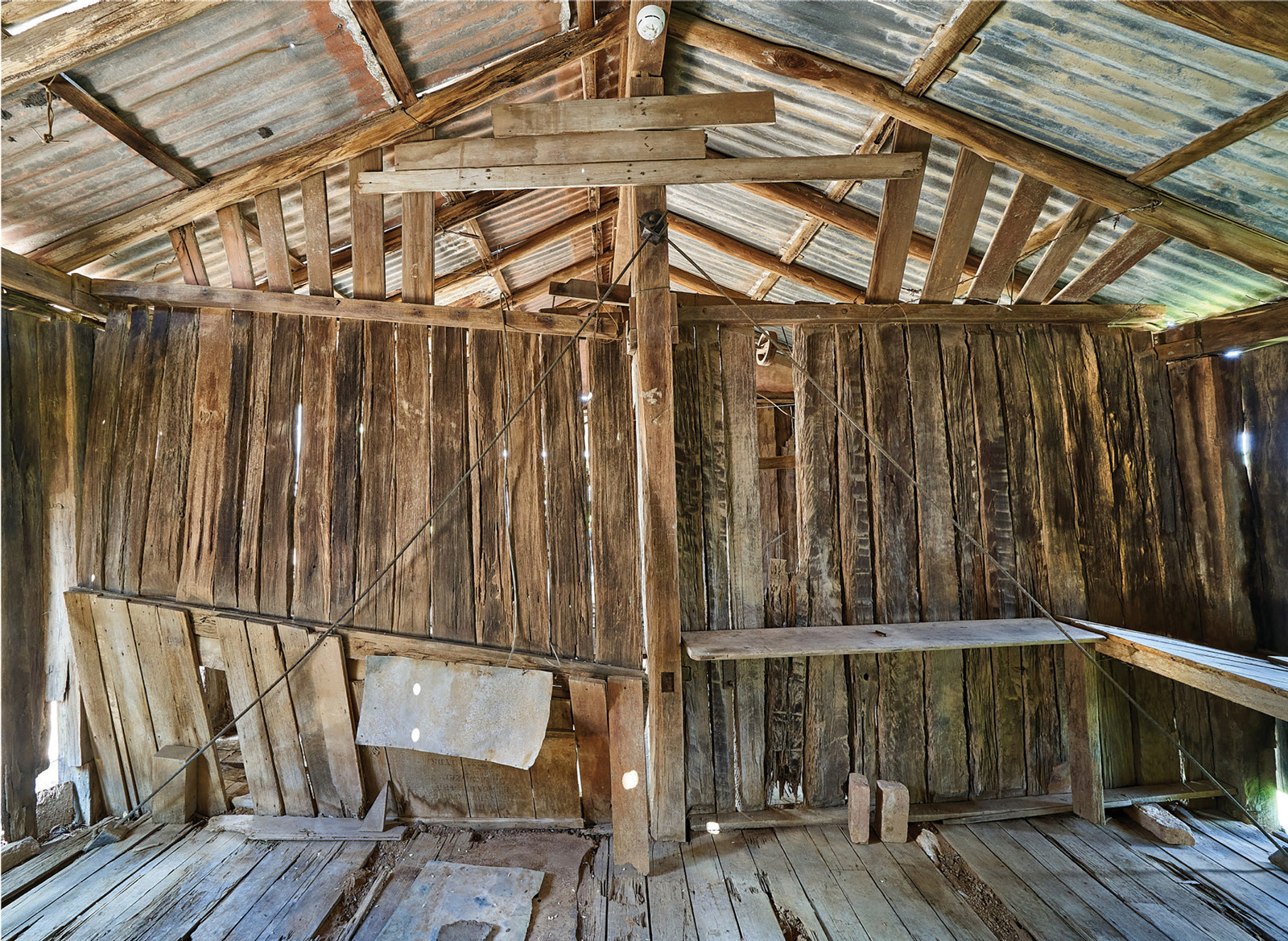A strong and simple structure: conserving the woolshed
The second phase of a major conservation project on the woolshed at Rouse Hill Estate has seen the rustic 160-year-old structure strengthened and stabilised.
The woolshed at Rouse Hill Estate, constructed around 1858, is an example of the type of ‘rude’ timber farm buildings that can be found throughout rural Australia. Usually uncomplicated structures built using readily available materials, these can have a naive yet beautiful character. The Rouse Hill woolshed is an illustration of this: a rectangular building constructed from vertical timber slabs with a corrugated-iron gable roof and later lean-to additions at each end. The weatherboard lean-to at the northern end houses a small pigeon coop, and the southern lean-to a carport.
The woolshed is one of 17 outbuildings grouped around a series of fenced yards to the south of Rouse Hill House, out of view of the Georgian mansion’s main entrance. Many of these buildings, including the woolshed, were constructed between 1857 and 1877 by Thomas Dickson, a Scottish carpenter employed by the Rouses as overseer. As a group, the farm buildings at Rouse Hill are of considerable historical significance, providing evidence of mid-19th- to early-20th-century construction techniques and farming practices.
The range of buildings on the estate also illustrates the efforts of the Rouse and Terry families to make their property financially viable over many decades – a proposition that became more difficult from the 1890s onwards owing to a series of droughts and economic depressions. Evidence shows that part of the woolshed was used as a small night stable, and oral histories record that the structure was used by the Rouse family for the temporary storage of wool bales being brought to Sydney from their other properties. In the 20th century it was used as a workshop for maintaining farm equipment, and for storage.
Years of hidden decay
The central structure of the woolshed is divided into three rooms with structural timber posts and a ridge beam running through the centre of the building. The toolroom has a brick paved floor, while the engine and harness rooms feature hardwood boards, supported on timber joists, laid directly on the ground. Reflecting the building’s changing use over time, when Museums of History NSW (then the Historic Houses Trust) took ownership of the estate in 1987, the three rooms held an eclectic collection of discarded domestic objects, farm equipment, vehicle parts, tools, machinery and hardware, sitting on top of, under and behind workbenches and timber cupboards accumulated as farming activity at the property declined.
Since 1987, the woolshed has been subjected to various repairs, including replacement of post bases, rafters and roof sheets, and localised strengthening with steel bracing and brackets. The majority of these works were undertaken in 1996–97. As is to be expected of a timber structure in direct contact with the ground and exposed to the elements, the woolshed has suffered years of deterioration caused by pest activity such as white ant, borer and rabbits, as well as wet rot (fungus that thrives in high-moisture environments). The decay has caused posts to rot at their bases, beams and joists to lose their integrity and roof sheets to leak. Over time, the building has tilted and settled, becoming structurally compromised.
Preservation and repair
In 2020, as part of our capital maintenance program, SLM committed funds to empty the woolshed of its contents and address the deterioration. A team of specialised engineers and pest management professionals with wide experience in heritage conservation was engaged to work closely with SLM’s Heritage and Collections & Access teams to undertake the repair and conservation works.
The project was divided into two stages. The first stage involved documenting all of the building’s contents in situ; the painstaking removal, cataloguing and storage of all objects and furniture; and testing for and clearing hazardous materials such as asbestos and pesticides historically stored in the building. In November 2020, the second stage of the project began, with extensive conservation works on the building fabric.
SLM’s approach to conservation at Rouse Hill Estate is guided by the Burra Charter, an internationally recognised set of guidelines that define the basic principles and procedures to be followed in the conservation of heritage places. Article 3.1 of the charter advocates doing as much as necessary to care for the place and to make it usable, but otherwise changing as little as possible. For the woolshed project we took a dual approach of preservation (taking steps to ensure that existing timbers, original or more recent, will be protected from further decay) and repairing the structural components or members in such a way that they will again perform the function for which they were designed.

The beauty of simplicity
The building’s original joinery – such as scarf and mortice and tenon joints, rounded grooved wall plates and bush pole rafters – demonstrates techniques used by local labourers in constructing simple timber buildings for hundreds of years. Remarkably, some of these are still performing effectively, and they’ve been replaced only where needed.
Another simple but unusual structural detail was the use of timber struts or buttresses at the base of posts on the eastern and western sides of the building, extending about a metre into the ground at a 30-degree angle. After the decayed remains of these struts had been documented, some were removed in order to splice or replace some posts. These posts were extended an extra half-metre to provide a strong foundation.
A combination of new timber members, splicing (new timber bolted to old members, a technique largely used in beams and posts) and steel tensioning (wire cross-braces and plates) has been incorporated to aid the retention of original material and provide additional strengthening. This has returned structural integrity to the posts and beams, while the significant timber wall slabs, floorboards and internal panelling have been treated to slow down their deterioration.
To differentiate the current works from original details and subsequent repairs, all new material has been date-stamped and documented photographically.
This interesting and complex conservation project has given a new lease of life to a building that has – somewhat miraculously – already survived more than 160 years. The works will allow the collection objects to be returned to a safe environment, and the public to be able to visit and experience this small but significant aspect of the Rouses’ and Terrys’ lives at Rouse Hill Estate for years to come.
Project team
Structural engineers: Partridge Pty Ltd
Hygienists: Hibbs & Associates Pty Ltd Pest management: Modified Atmospheres Pty LtdBuilder: MJ Bielby Constructions Pty Ltd
Published on
